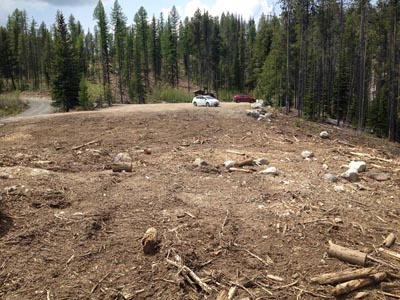The Colville National Forest turns a deaf ear to collaboration
Sad as it is true, the U.S. Forest Service, Colville National Forest (CNF) has returned to its old right-brained habit of ignoring public input, clearcutting and logging ancient forest as evidenced in the Sherman Pass Project. I spent six years collaborating with the CNF on this project. The CNF said it would not be clearcutting the forest, but it did so, a lot. Despite criticism from collaborative interests, the Forest Service is adamant that it did the right thing – and in a Scenic Byway no less.
A similar fate is planned for the San Poil, Dollar Mountain and Bulldog projects – like Sherman -- in the Kettle Crest. These are BIG projects – San Poil alone is projected to fill 12,000 log trucks.
The Deer-Jasper Project at Boulder Pass, though not quite as smash & grab ugly as Sherman, but that’s because the project was changed due to results of the Stickpin Fire (2015). Stickpin roared through previous logging units and huge clearcuts which were mostly cleared of slash. In neither Sherman nor Deer-Jasper project did Forest Service leadership listen to public input or honor its promise to design a project based on collaboration that itself facilitated.
Project collaboration takes a lot of time, generally over several years. But lately outcomes of collaboration are more like those from the 1980’s and 1990’s. That period is often referred to as the Timber Wars. And it’s not like KRCG has been fighting timber sales for the last 19 years – not at all. What seems to be behind this return to the bad old days is forest leadership and fitting of Einstein’s insanity aphorism, “doing the same thing and expecting different results.”
The euphemisms used today to describe the urgent need for logging to restore forest health are truly Ozlike. The forest is “the wrong mix” and of “too many trees.” Oh my! Dang it Nature, get with the program! And of course, cutting & hauling away the forest will prevent catastrophic wildfire, insect and disease. Whereas dead trees tell no tale – 500,000 acres of shrub, wheat and grass land that burned in Washington in 2020 tell a different story. Read more “Fire Suppression Hyperbole” in this newsletter.
For millennia, trees have grown and died, adding to soil carbon, creating insect & wildlife habitat and a seedbed upon which a new forest grows. Look for yourself at White Mountain fire, Copper Butte, Mt. Leona and so many more past fires. Did the forest grow back nicely spaced after a wildfire disturbance? No, regrowth forms thickets of shrubs and saplings, especially on wet and northerly aspects.
I’ve been thinking quite a lot about this sea change in CNF management, trying to understand how 19 years of investment by KRCG working with the CNF and the Northeast Washington Forest Coalition has been for naught. Back in about 2004, the Forest Service hired professional consultants to teach timber industry and us forest conservationists how to resolve conflicts through shared interests.
Which is exactly what KRCG intends to keep doing. It’s what the membership cares about: protecting wildlife, clean water and wild forest ecosystems. We support projects that maintain scenic integrity, wildlands and biological diversity. We WILL oppose those that do not.
Unfortunately, the revised Colville Forest Plan (circa September 2019) is guiding us toward conflict. Clearcuts (aka regeneration) will, to quote: “generally be less than 40 acres…and a few larger patches up to 1,000 acres or more in size.” (p 35, Land Management Plan). Wow! Does that sound collaborative? Not to me it doesn’t. Nor do I think KRCG volunteers, local folk who participated in development of this plan -- that dragged on for 17 years -- support clearcutting our national forests!
It’s back to future time. So when the toadies complain about lawsuits and “hurtful” statements, please remember, we tried. History will not forget.
But there's always hope "healthy forests" will actually contain trees. |
|
 |
